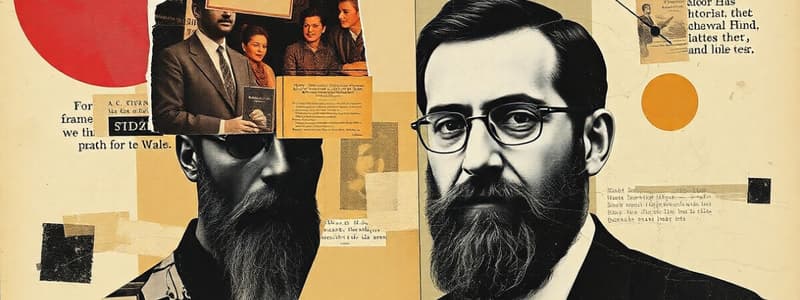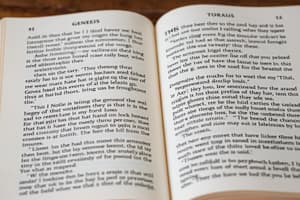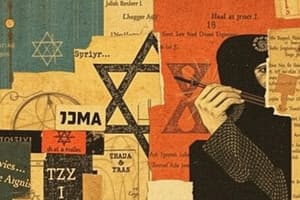Podcast
Questions and Answers
What is the significance of Kabbalah when it contradicts Halacha?
What is the significance of Kabbalah when it contradicts Halacha?
- Halacha is prioritized unless explicitly stated otherwise.
- Both Kabbalah and Halacha are equally considered.
- We give preference to Kabbalah over Halacha. (correct)
- It is always ignored in favor of Halacha.
What role do drashos play in relation to Kabbalah?
What role do drashos play in relation to Kabbalah?
- They provide a method to remember Kabbalah. (correct)
- They are irrelevant to the understanding of Kabbalah.
- They can contradict Kabbalah without consequence.
- They serve as a permanent replacement for Kabbalah.
What can result from a later Beis Din disputing a drasha?
What can result from a later Beis Din disputing a drasha?
- The drasha is elevated to Deoraysa status.
- All previous Halacha must be discarded.
- The drasha remains unchanged indefinitely.
- New Halacha can be generated from the debate. (correct)
What is the status of halachos generated by the 13 Middos?
What is the status of halachos generated by the 13 Middos?
What is the issue surrounding the marriage of Moavi women to Jews?
What is the issue surrounding the marriage of Moavi women to Jews?
What is a consequence of losing a halacha after a pivotal event?
What is a consequence of losing a halacha after a pivotal event?
How does Kabbalah differ from Halacha L’Moshe Misinai?
How does Kabbalah differ from Halacha L’Moshe Misinai?
Why are Amoni and Moavi people prohibited from marrying into Klal Yisroel?
Why are Amoni and Moavi people prohibited from marrying into Klal Yisroel?
What is implied about the mitzvos in relation to Yetzias Mitzrayim?
What is implied about the mitzvos in relation to Yetzias Mitzrayim?
According to the content, what is the relationship between Pesach, Matzah, and Marror?
According to the content, what is the relationship between Pesach, Matzah, and Marror?
How did the Avos keep Mitzvos before Matan Torah according to the content?
How did the Avos keep Mitzvos before Matan Torah according to the content?
Post Matan Torah, how is the performance of mitzvos described?
Post Matan Torah, how is the performance of mitzvos described?
What must be believed about the Torah Shebichtav according to the content?
What must be believed about the Torah Shebichtav according to the content?
What distinction is made between narrative and command in understanding Mitzvos?
What distinction is made between narrative and command in understanding Mitzvos?
What role do Poskim have in relation to Mitzvos post-Matan Torah?
What role do Poskim have in relation to Mitzvos post-Matan Torah?
Why is it necessary to look closely at the structure of the Pussuk according to the content?
Why is it necessary to look closely at the structure of the Pussuk according to the content?
What is the relationship between Torah Shebichtav and Torah Shebaal Peh in terms of Halacha?
What is the relationship between Torah Shebichtav and Torah Shebaal Peh in terms of Halacha?
How can mitzvos be conveyed according to the provided content?
How can mitzvos be conveyed according to the provided content?
What are the two categories of Kabbalos received at Har Sinai?
What are the two categories of Kabbalos received at Har Sinai?
Which of the following correctly describes Maaser Sheni according to the content?
Which of the following correctly describes Maaser Sheni according to the content?
What does the phrase 'som Tasim alecha Melech' refer to?
What does the phrase 'som Tasim alecha Melech' refer to?
Which interpretation method is NOT mentioned for understanding concepts from Torah Shebichtav?
Which interpretation method is NOT mentioned for understanding concepts from Torah Shebichtav?
What does Kabbalah teach about 'an eye for an eye'?
What does Kabbalah teach about 'an eye for an eye'?
How can the term 'Pri Eitz Hadar' be understood through Kabbalah?
How can the term 'Pri Eitz Hadar' be understood through Kabbalah?
What is the significance of deriving a Mitzvah from a command phrase?
What is the significance of deriving a Mitzvah from a command phrase?
Why can't Avraham's act of giving a Bris Milah serve as the source of the Mitzvah?
Why can't Avraham's act of giving a Bris Milah serve as the source of the Mitzvah?
What does the statement 'what a person says is not necessarily true' imply about quoted speech?
What does the statement 'what a person says is not necessarily true' imply about quoted speech?
In the context of Bikkurim, what is the nature of the statements that must be recited?
In the context of Bikkurim, what is the nature of the statements that must be recited?
What important lesson does the phrase about Yocheved imply regarding her actions?
What important lesson does the phrase about Yocheved imply regarding her actions?
What is a general rule regarding deriving Mitzvah Deoraysa from quoted speech?
What is a general rule regarding deriving Mitzvah Deoraysa from quoted speech?
What does the phrase 'middos Chassidus' refer to in relation to stories about mitzvot?
What does the phrase 'middos Chassidus' refer to in relation to stories about mitzvot?
What does the Kessef Mishnah emphasize about the need for both a Pussuk and clarification?
What does the Kessef Mishnah emphasize about the need for both a Pussuk and clarification?
What is the primary source of the mitzvos drabanan according to the chazal?
What is the primary source of the mitzvos drabanan according to the chazal?
Why did the chachamim wait a year before instituting the mitzvah of Chanukah?
Why did the chachamim wait a year before instituting the mitzvah of Chanukah?
What unique power do we have concerning the new moon cycle as mentioned in the content?
What unique power do we have concerning the new moon cycle as mentioned in the content?
Which of the following statements reflects the role of the Torah in understanding the actions of the Avos?
Which of the following statements reflects the role of the Torah in understanding the actions of the Avos?
What does the chiddushei HaRim suggest about the nature of Chanukah?
What does the chiddushei HaRim suggest about the nature of Chanukah?
What does the content imply about the process of instituting mitzvos based on the Avos?
What does the content imply about the process of instituting mitzvos based on the Avos?
How does the concept of re-experiencing a holiday apply to Chanukah?
How does the concept of re-experiencing a holiday apply to Chanukah?
What is the relationship between mitzvos d'Rabbanan and the Torah's teachings?
What is the relationship between mitzvos d'Rabbanan and the Torah's teachings?
What is the overall theme of the section regarding Melacha on Shabbos?
What is the overall theme of the section regarding Melacha on Shabbos?
What does the term 'Lav Shebiklalos' refer to in this context?
What does the term 'Lav Shebiklalos' refer to in this context?
What is the general principle regarding the relationship between Pshat and Drash interpretations?
What is the general principle regarding the relationship between Pshat and Drash interpretations?
According to the example given, how is Yovel related to the status of an Eved Ivri?
According to the example given, how is Yovel related to the status of an Eved Ivri?
In the context of Matzah, what is the interpretation of the obligation to eat for 7 days versus 6 days?
In the context of Matzah, what is the interpretation of the obligation to eat for 7 days versus 6 days?
What role does Drash play in the interpretation of Mitzvot according to the information provided?
What role does Drash play in the interpretation of Mitzvot according to the information provided?
What does it mean when a Mitzvah is considered 'deoraysa'?
What does it mean when a Mitzvah is considered 'deoraysa'?
How can the contradiction between Pshat and Drash be reconciled in Halacha?
How can the contradiction between Pshat and Drash be reconciled in Halacha?
Flashcards
Mitzvos Pre-Exist
Mitzvos Pre-Exist
The idea that mitzvos (commandments) existed before the world was created, and were not created as a result of historical events like the Exodus.
Mitzvos Based on Nature
Mitzvos Based on Nature
The ability to recognize and understand mitzvos through natural observation and intuition. This was the way the Avos (Patriarchs) kept mitzvos before the giving of the Torah.
Mitzvos After Matan Torah
Mitzvos After Matan Torah
The giving of the Torah at Mount Sinai provided more structured and defined guidelines for fulfilling mitzvos. This approach emphasized a more formal and intentional approach to keeping mitzvos.
Mitzvos Deoraysa
Mitzvos Deoraysa
Signup and view all the flashcards
Halacha Deoraysa
Halacha Deoraysa
Signup and view all the flashcards
Torah SheBichtav is Perfect
Torah SheBichtav is Perfect
Signup and view all the flashcards
Structure of the Torah
Structure of the Torah
Signup and view all the flashcards
Chachamim as Scientists
Chachamim as Scientists
Signup and view all the flashcards
Source of a Mitzvah
Source of a Mitzvah
Signup and view all the flashcards
Stories and Mitzvot
Stories and Mitzvot
Signup and view all the flashcards
Quoted Speech & Mitzvot
Quoted Speech & Mitzvot
Signup and view all the flashcards
Exceptions for Quoted speech
Exceptions for Quoted speech
Signup and view all the flashcards
Bikkurim & Mitzvah Source
Bikkurim & Mitzvah Source
Signup and view all the flashcards
Torah's Authority vs Human Speech
Torah's Authority vs Human Speech
Signup and view all the flashcards
Example of Moshe's Birth
Example of Moshe's Birth
Signup and view all the flashcards
Deorayssa Mitzvah
Deorayssa Mitzvah
Signup and view all the flashcards
Torah Sheba'al Peh: Divine Origin
Torah Sheba'al Peh: Divine Origin
Signup and view all the flashcards
Oral Law: What is it?
Oral Law: What is it?
Signup and view all the flashcards
Oral Law: Received at Sinai
Oral Law: Received at Sinai
Signup and view all the flashcards
Oral Law: Deorayssa and D'Rabbanan
Oral Law: Deorayssa and D'Rabbanan
Signup and view all the flashcards
Oral Law: Importance of Written Law
Oral Law: Importance of Written Law
Signup and view all the flashcards
Oral Law takes precedence
Oral Law takes precedence
Signup and view all the flashcards
Divine Teachings at Sinai
Divine Teachings at Sinai
Signup and view all the flashcards
Kabbalah: Oral Law Rooted in Torah
Kabbalah: Oral Law Rooted in Torah
Signup and view all the flashcards
Halacha L'Moshe Misinai
Halacha L'Moshe Misinai
Signup and view all the flashcards
Drashos
Drashos
Signup and view all the flashcards
Kabbalah vs. Halacha
Kabbalah vs. Halacha
Signup and view all the flashcards
Drashos - Connecting the Torah
Drashos - Connecting the Torah
Signup and view all the flashcards
Drashos - Restoring and Deriving Laws
Drashos - Restoring and Deriving Laws
Signup and view all the flashcards
Drashos - Debatable Laws
Drashos - Debatable Laws
Signup and view all the flashcards
Moabite Women and Judaism
Moabite Women and Judaism
Signup and view all the flashcards
Prohibition on Ammonite and Moabite Marriage
Prohibition on Ammonite and Moabite Marriage
Signup and view all the flashcards
Multiple interpretations (Drash & Pshat)
Multiple interpretations (Drash & Pshat)
Signup and view all the flashcards
Pshat-based halacha
Pshat-based halacha
Signup and view all the flashcards
Mitzvah expansion
Mitzvah expansion
Signup and view all the flashcards
Reshus (permission)
Reshus (permission)
Signup and view all the flashcards
Chiyuv vs. Reshus
Chiyuv vs. Reshus
Signup and view all the flashcards
Essential halacha vs. exceptions
Essential halacha vs. exceptions
Signup and view all the flashcards
Examples in understanding Mitzvos
Examples in understanding Mitzvos
Signup and view all the flashcards
Reconciling different interpretations
Reconciling different interpretations
Signup and view all the flashcards
Study Notes
Torah Min HaShamayim
- Torah Shebichtav and Torah Shebaal Peh are both from G-d with different characteristics
- Torah Shebichtav contains G-d's words, and is fixed in content and form
- Torah Shebaal Peh is delivered in content, but the exact words are determined by scholars rooted in the Torah Shebichtav
Emunas Chachamim
- We must trust scholars' interpretations as reliable, as they pass down tradition correctly
Halacha as Natural Law
- Two types of laws: dos and don'ts, and reality
- Halacha mirrors scientific laws, encompassing timeless truth
- The Avos (patriarchs) understood G-d's blueprint of reality, even without explicit instruction
Beis Halevi's Perspective
- Mitzvot (commandments) are relevant today
- Despite lacking clear connections to modern practice, they represent a fundamental understanding of G-d in the world
- The response to questions regarding relevance in today's society lies within the Torah itself
Mitzvos Pre vs Post Matan Torah
- Pre-Torah: Mitzvos were based on natural observation and human creativity
- Post-Torah: Mitzvos became more structured and formal
Mitzvos Deoraysa/ Halacha Deoraysa
- Understanding how we know Deoraysa Mitzvos
- The importance of the text's structure and narrative
- Distinguishing between narrative and direct command
Torah Shebaal Peh & Halacha Deoraysa
- Torah Shebaal Peh has divine origin and encompasses Deoraysa and D'Rabanan Halacha.
- Moshe received 13 attributes and Kabbalos (things received) at Mount Sinai
- Oral tradition is more important compared to written scripture, for determining contemporary halacha
The Role of the Pussuk
- The pussuk (verse) plays a crucial role in determining which acts are required, and which actions should be avoided.
Studying That Suits You
Use AI to generate personalized quizzes and flashcards to suit your learning preferences.




